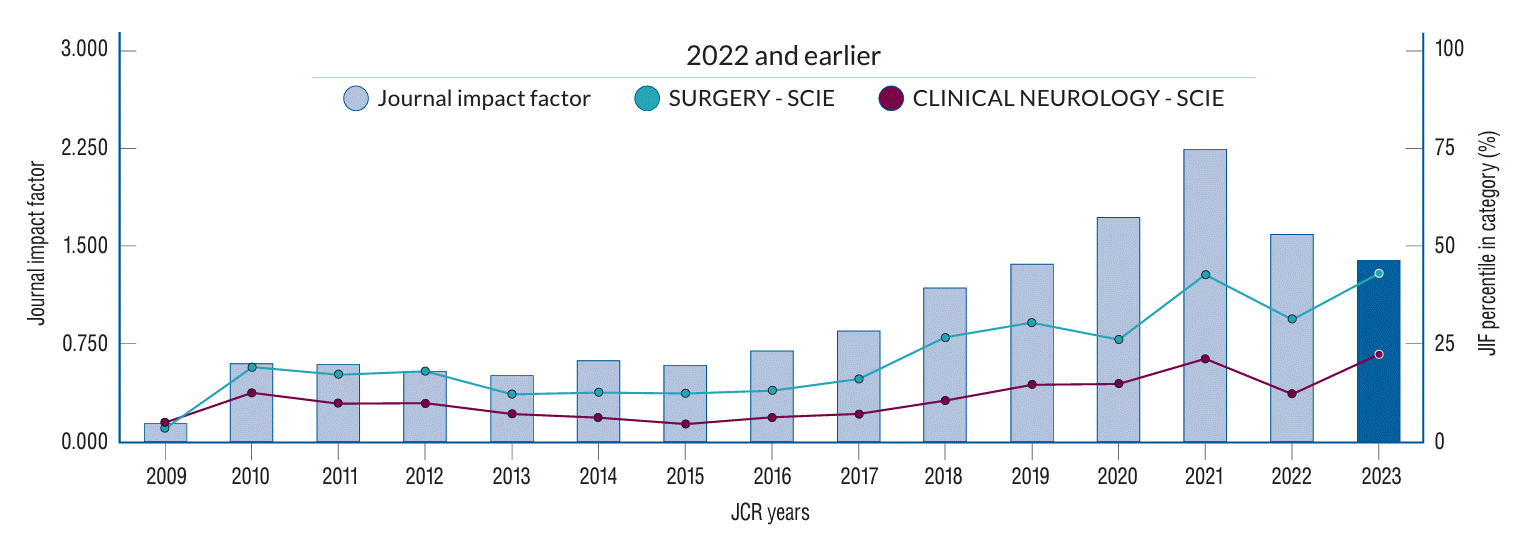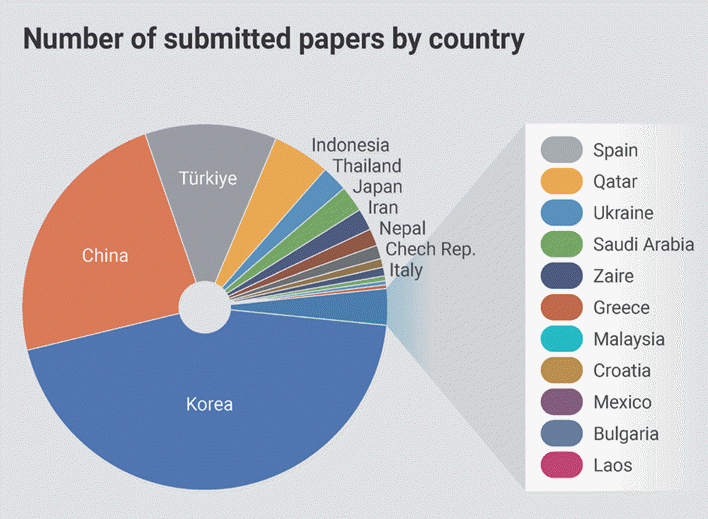This article has been
cited by other articles in ScienceCentral.
Abstract
Journal of Korean Neurosurgical Society (JKNS), which has a history of over 50 years, has made great progress recently. In order to continue this progress in the future, we need to think about the strategies we will take and put them into practice. The progress of JKNS is an important opportunity to publicize the achievements of Korean neurosurgery to the world and for Korea to contribute further to global neurosurgery. We also need to think about and implement various measures to improve the inflow of papers of high quality from various countries and to establish an appropriate merit system for reviewers.
Go to :

Keywords: J Korean Neurosurg Soc, Journal impact factor, Neurosurgery
INTRODUCTION
Among the about 30000 medical journals published in the world, only a small portion of them have a significant impact on medical science [
7]. Many journals work hard to improve their reputation, but it is not easy to achieve what they want. As new journals emerge every year, competition becomes fiercer, and it is difficult to keep up with the achievements of existing journals with established reputation. The most important thing that medical journals are interested in is the improvement of the impact factor (IF). The improvement of IF, which measures how many times the articles published in the journal are cited, is the top priority for all medical journals. Although there are some negative views on the IF as a standard for determining the entire value of a medical journal, there is no better indicator that explains the status of an academic journal better than IF in a simple manner [
8].
Since the enlistment in Scientific Citation Index (SCI) in 2008, the IF of
Journal of Korean Neurosurgical Society (
JKNS) remained at a low level for about 10 years. Various reorganization and efforts have been made to improve the IF, and it began to rise from the year 2018, achieving the highest value on 2021 (2.249) [
6,
11]. However, it declined thereafter, 1.7 at 2022 and 1.4 at 2023 [
3,
4].
It is thought that this is the right time to ponder on what efforts are to be made to improve the status of JKNS from a long-term perspective. This article discusses the efforts made so far and the results, and the ways to be taken in the future for sustainable development.
Go to :

ACHIEVEMENTS OF JKNS
Although there is a recent decrease, the IF is about 1.5, a much improved score compared to those of between 2009 to 2017 (
Fig. 1). It ranks 165 among 290 surgery journals (Q3). The title is ‘
Journal of Korean Neurosurgical Society’, however, about half of the submitted manuscripts come from other countries, and there are articles from foreign authors with considerable citations, which means it is now a journal with international reputation [
10] (
Fig. 2).
 | Fig. 1.Changes of impact factors (IF) of Journal of Korean Neurosurgical Society [ 4]. After getting 2.249 on 2021, it declines in 2022 and 2023. JIF : journal impact factor, JCR : journal citation report. 
|
 | Fig. 2.Number of submitted papers to Journal of Korean Neurosurgical Society by countries in the year of 2023. About half of the papers come from foreign researchers. 
|
In order to improve IF, the denominator, the number of articles published, is to be decreased and the numerator, the number of citations, is to be increased. It was found that 53% of articles published got no citation at all, therefore, it was decided to scrutinize the review process to filter out the manuscripts of low probability of citation, and the number of issues per year was reduced to 6 from 12 since 2016 [
2,
6]. One of the useful strategies for journals that have difficulty in getting manuscripts with high probability of citation is to solicit review articles from renowned researchers.
JKNS editorial board requested review articles from famous foreign and Korean researchers and tried to publish two or more review articles per every issue. The other measure for reduction of articles with low probability of citation is limitation of the number of published case report. Although case report is one of the useful types of articles in circulation of new and rare findings, it has low probability of citation compared to original article or review article. Therefore, it is desirable to carefully select only a small portion of submitted manuscript with a high likelihood of citation. The difference of citations according to type of articles was demonstrated by data of
JKNS (
Table 1) [
7].
Table 1.
Citations according to type of articles (from journal citation report 2022 and impact factor of Journal of Korean Neurosurgical Society)
|
Number |
Citations |
Citations per articles |
|
Original article |
142 |
206 |
1.45 |
|
Review |
43 |
85 |
1.98 |
|
Case report |
4 |
3 |
0.75 |

To make researchers interested in the
JKNS for submission, the editorial office started to send out table of contents of new issues and a list of top cited articles to members of Korean Neurosurgical Society (KNS) and past-authors at the time of publication of every new issue since 2018 [
5]. The other efforts to improve IF of
JKNS are notifications for authors when their articles are cited, posting of authors of highly cited articles with their photographs, posting of reviewers who reviewed the submitted manuscripts faithfully, and early online publication of accepted articles before it was posted in printed form.
It was thought that these various efforts have made an impact on achieving the peak value of IF 2.249 in journal citation report 2021.
Go to :

TACTICS FOR SUSTAINABLE PROGRESS OF JKNS
To make sustainable progress, the measures which have been proved to be useful are to be maintained. Considering the difference in citation according to the type of articles (
Table 1), the policy of recruiting review articles of hot topics and screening of case reports of low probability of citation is to be continued. It is more practical to filter out manuscripts of low probability of citation than to manipulate to increase citations of published articles. It was revealed that the proportion of articles which got no citation at all has a significant influence on the IF of
JKNS [
9]. Therefore, we are to continue these efforts in the future. Due to the nation-wide crisis in medical system in 2024, it was found that the number of submitted articles decreased significantly, especially in domestic submissions. It might be prudent to selection of manuscripts with high probability of citation, rather than focusing on maintaining the number of articles published.
There is a somewhat critical view that the journal’s name contains the word ‘Korean’, which gives it a non-global impression. However, rather than thinking that the word Korean gives a negative impression, it is also meaningful to serve as a window that presents important data from Korea. In-depth examination of Korea’s epidemiological data on diseases and treatment results can be a good topic that widely publicizes the achievements of Korean neurosurgery and increases the possibility of citation.
One of the crucial factors for the progress of JKNS is the competent reviewers. JKNS is a journal with international recognition but not yet a prominent status. Considering the status, manuscripts submitted to JKNS may not be perfectly organized. It is very important to go beyond simply judging them as acceptable or unacceptable rather supplementing their shortcomings by constructive review. Despite the importance of the reviewers, there was no proper way to reward their hard work. Although the editorial board selects excellent reviewers and posts them in the January issue once every 2 years, this does not seem to be enough. The editorial board launched a reviewer merit system in 2023. When a reviewer finished the review process within the due date for five manuscripts, the reviewer can publish their manuscript with an exemption of article publishing charge (APC, 400 US dollars). To encourage the participation of foreign reviewers, they only have to finish the review for three manuscripts, not five. Most reviewers are potential contributors to JKNS; therefore, this reviewer merit system will have a positive impact on the expedition of the review process and submission of more manuscripts in addition to appropriate reward for the reviewers.
The progress of JKNS may be accomplished by contribution to global neurosurgery. There are still many countries that do not have their own SCI-indexed journals. This is especially true in low- and middle-income countries (LMIC). Researchers in these countries have difficulty publicizing their results internationally even though they accomplish good research. JKNS is already receiving many foreign papers. Although its IF is not top-class, it has a certain level of recognition. JKNS’s APC is lower than those of other journals and it provides deduction in APC for researchers from LMICs, so it can be a good way of publishing their works for these countries. If the manuscript review process is expedited, it is expected to become a more attractive journal for foreign researchers. Even though the manuscript is assessed to be unsuitable for publication in JKNS, it can be transferred to journals of branch societies of KNS, to give it another chance for publication. Although those journals are not yet indexed in SCI except for Neurospine, official journal of Korean Spinal Neurosurgery Society, they are indexed in SCOPUS, PMC, etc., which can help them to be searched on international database and to be cited. Those articles from countries that do not have their own SCI-indexed countries, which provide valuable information not available in other journals, might be helpful in improvement of the reputation of JKNS and IF.
In 2021, the IF of almost all medical journals increased, and this is thought to be due to the ‘inflation’ of the IF caused by the COVID-19 outbreak [
1]. Nonetheless, it is very important to maintain the IF at a certain level, and the IF is not only the reputation of the journal but also the most powerful incentive to attract good manuscripts.
Go to :

CONCLUSIONS
JKNS has achieved fairly decent achievements. It is the result of efforts and cooperation of authors, reviewers, editorial board and KNS. Now, we need to internationalize this collaboration and make better strategies so that JKNS can become a medical journal with a high IF and a good role in global neurosurgery.
Go to :






 PDF
PDF Citation
Citation Print
Print




 XML Download
XML Download